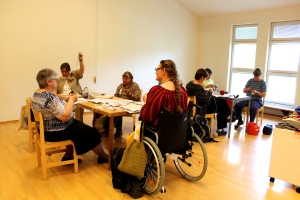Tagged: Karin Kahnlund
Two-end knitting and crochet
I took a class in intermediate two-end knitting for Karin Kahnlund, one of the skilled Swedish knitters and teachers in this intricate technique. You may know it as “twined knitting”, a term that is also frequently used. It’s called “tvåändsstickning” in Swedish. The technique hasn’t been widely known outside the areas in Sweden where it has been practised for hundreds of years. It’s still an unknown way of knitting for most knitters. I first learned how to do it at the beginning of the 21th century, when I was able to attend a class with Marianne Wasberg. She’s the one sitting in the wheel chair here in our class at the Symposium:
I somehow managed not to take a photo of our pleasant and skilled teacher. I did take photos of her mittens, but as she doesn’t want them to be published I can’t show them. Karin has made very beautiful knitted mittens and sleeves, as you can see from the few photos on her site.
I may show Karin’s swatch that we started knitting in the class:
My swatch is still to be finished. I frogged the first one and started all over. After several hours of knitting I’ve come this far:
I wanted to show the wrong side, because it’s different from how you usually knit stranded knitting and fair isle. Every stitch is bound or twisted, and you throw the yarns. The continental way of knitting doesn’t work in two-end knitting. I’m pleased with the swatch as it looks now compared to the one I first started knitting. You have to knit firm, otherwise the patterns won’t look nice. In this exercise you learn how many threads you need to use in each pattern, and how they are bound and twisted.
In two-end knitting you use Z-twist yarns, so now I have a new challenge in my spinning. For some reason I find it much more difficult to spin S than Z. I think it has to do with very small changes in how you use your muscles in your drafting hand. So, the way to cope with that is to spin more S-twist singles to train your muscles! We use Z-twisted yarns because S-twisted tend to loose rather much twist in this technique. This is of course, as so often when it comes to textiles, a matter of “it depends”. Your personal way of knitting, how you keep your yarns in your hands, how you pick the stitches or throw your yarns, whether you’re right handed or left handed, all this affect the yarns and how your knitting looks. So, test different ways and decide for yourself how you want to do it.
I also got engaged as a teacher at the Symposium, and found myself having promised to teach tapestry crochet at a knitting symposium. To my surprise my class was quite popular, so I ended up with more students than I had promised to take. It was a bit crowded in one of the classes, but we managed even if my legs still are covered with bruises from the table and chairs I had to round each time I wanted to show someone what to do 🙂 I chose the traditional Ostrobothnian way to crochet this technique. My students learned the basics and some of them were able to finish the round, flat bottom of a purse. At least one of them had finished the sides of her purse the following morning! This is a photo I took while working with the hand outs for my class:
We also could to listen to some very interesting talks during the five days, and we visited several museums and saw some of the beautiful textiles from my region. I met new people, and some that I’ve met earlier in Scotland, Shetland, Finland, Sweden. It was a wonderful five days!



